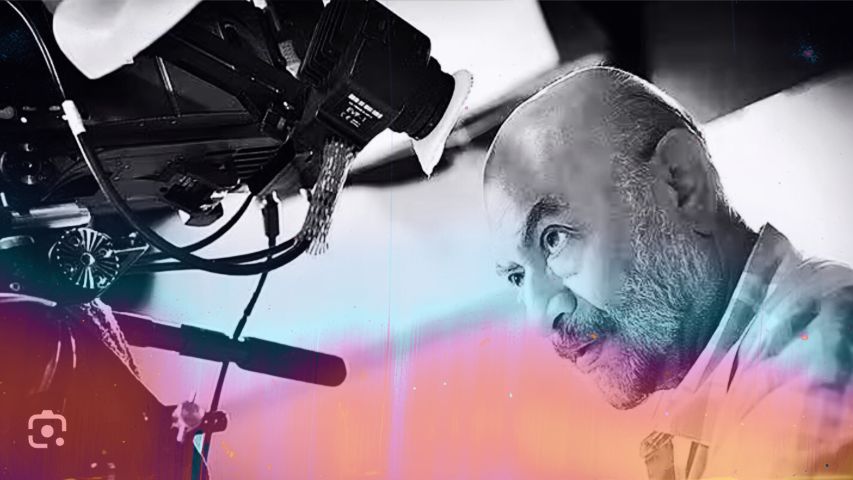-853X543.jpg)
ARDH SATYA: TRAPPED IN A LABYRINTH OF DECEPTION
by O.P. Srivastava September 29 2023, 12:00 am Estimated Reading Time: 4 mins, 48 secsO.P. Srivastava travels back in time to reflect on Govind Nihalani’s Ardh Satya (Half Truth) written by Vijay Tendulkar, a blockbuster in the 1980s.
Ardh Satya is a 1983 Hindi film directed by Govind Nihalani, his second after the angst-ridden Aakrosh. Manmohan Shetty and Pradeep Uppoor produced the film. Based on the short story Surya by SD Panvalkar, it is said that Ardh Satya was inspired by the real-life battle between Vardrajan Mudaliar, the don of Dharavi-Matunga, and the then Deputy Commissioner of Police, YC Pawar. Vijay Tendulkar wrote the film’s screenplay.
Renu Saluja, a four-time recipient of the National Award, edited the film, which has a runtime of 130 minutes. Vasant Dev, a writer, lyricist, screenwriter and a Hindi academic at Parle College in Mumbai, wrote the dialogues. Dev worked in Hindi parallel cinema through the 1980s, alongside directors like Shyam Benegal, Nihalani and Mahesh Bhatt. He is best known for writing ‘Sanjh Dhale Gagan Tale’ sung by Suresh Wadkar and ‘Man Kyun Behka’, a Lata Mangeshkar and Asha Bhonsle duet in Utsav (1984), directed by Girish Karnad.
The film stars Om Puri, Smita Patil, Amrish Puri, Sadashiv Amrapurkar, Shafi Inamdar, Naseeruddin Shah and Madan Jain. Puri won the National Award for Best Actor for this film in 1984. At the same time, Nihalani won Best Director and the producers got the National Award for Best Film.
Nihalani started as an ad filmmaker and went on to work on eight of Shyam Benegal’s films, including Manthan, Nishant, Bhumika and Junoon, as a cinematographer. After successfully branching off on his own with Aakrosh, Nihalani became an institution of parallel cinema movement with Vijeta (1982), Ardh Satya (1983), Party (1984), Tamas (1987 - a TV series), Drohkaal (1994) and Hazaar Chaurasi Ki Maa (1997). Unlike Shyam Benegal, who believed in letting the actors improvise, Nihalani is known for demanding repeated takes until the actor produces the performance he is looking for.
On the surface, Ardh Satya is a story of an upright policeman, sub-inspector Anant Valenkar (Om Puri) from Gole Chowki police station, battling a cynical system. The character was too real to be ignored – he beats up a prisoner under trial in a moment of intoxication and heightened frustration, then uses the same corrupt system he detests to save his skin.
The stark authenticity of Ardh Satya’s characters stemmed from the space in which they existed. Rama Shetty (Sadashiv Amrapurkar) was not a villain-in-a-vacuum like commercial cinema’s baddies; he was a cog in the wheel of a corrupt political structure, manipulating his way up from being a petty don to an elected representative who could influence the working of the government to shield his nefarious activities.

Anant’s struggle with truths and half-truths about the operation of evil in society form the core of Ardh Satya’s bleak yet riveting story. The film is not merely an exposé of police corruption and misconduct; what makes it powerful is what it reveals the toll it takes on human beings who want to rise, but struggle to find the strength to do so.
Amrapurkar, a stage actor from Marathi theatre, with his large magnetic eyes, dark complexion, deep voice and silently intimidating body language made the character of Rama Shetty highly realistic and relatable - both for lovers of art cinema as well as commercial cinema audiences.
The gritty reality of Ardh Satya was Vijay Tendulkar’s forte, but the veteran playwright was equally perceptive about another important truth, that of the human mind. The story was path breaking not for just depicting the politics but also its subtext – it was the first film in which the protagonist’s central conflict was with his inner demons, rather than anything external. In this film, the plot was not the only significant part. The protagonist himself was equally impactful. Nihalani builds up the graph of Anant Velankar’s mental turbulence using the contrasting light and dark shades to reflect the aakrosh (anger) and ardh satya (half-truth) in the protagonist’s internal journey. The dialogues were hard-hitting, no holds barred.
In the middle of its intense drama, the film also features a poem (which gives the film its title), Ardh Satya, by the Marathi writer Dilip Chitre. The poem, which Velankar reads aloud, metaphorically describes the situation he is trapped in – the crossroads of life, where he finds himself in a losing battle with his own self. ‘Chakrvyuh mein ghusne se pehle kaun tha main aur kaisa tha? Yeh mujhe yaad hi na rahega’ (before entering the labyrinth of deception, who I was and what I was, I will not remember).
Several other parallel cinema films that preceded Ardh Satya were just as realistic and compelling, but they were quieter. Ardh Satya brought the pent-up angst, gritty drama and realism into the genre of popular cinema.
In the next decade, Ardh Satya also paved the way for a genre of films that dealt with the underworld; urban-centric films like Satya and Vastav, which portrayed the dark underbelly of Mumbai.
Ardh Satya was the first ‘art’ film to break the boundaries between parallel and popular cinema. It was the first art film to become as popular as a mainstream film, and it gave parallel cinema the acceptance and popularity it deserved.
This recognition of parallel cinema came in 1983–84, at the time when blockbusters like Coolie (Amitabh Bachchan, Rishi Kapoor), Razia Sultan (Hema Malini, Dharmendra) and Himmatwala (Jitendra, Sridevi) were released. With Aakrosh and Ardh Satya, the legendary Om Puri (one of the architects of parallel cinema) changed the face of Hindi cinema literally and metaphorically. He convinced the audience to look at the film rather than a face!




-173X130.jpg)
-173X130.jpg)
-173X130.jpg)
-173X130.jpg)
-173X130.jpg)
-173X130.jpg)
-173X130.jpg)
-173X130.jpg)